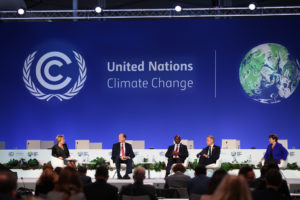Carbon Removal Is Not Enough to Save the Climate
The geo-engineering fix cannot match reducing emissions of greenhouse gases as a way of slowing global warming, analysts say. Billions of tons of carbon dioxide are emitted annually. (Carsten Wiehe / Wikimedia Commons)
Billions of tons of carbon dioxide are emitted annually. (Carsten Wiehe / Wikimedia Commons)
New studies from the US provide an answer to one of the thorniest questions facing climate policymakers: carbon removal will not replace stringent reductions in greenhouse gas emissions enough, they say, to avert the threat of global warming.
In a world making (so far) only halting progress to cut the pollutants that heat the planet through reducing emissions there is support for a different approach, using carbon removal and other forms of geo-engineering rather than emission cuts to remove the pollution already in the atmosphere, the oceans and the biosphere.
If we can be certain the gains will exceed the risks, then geoengineering might even let us avoid any need to cut fossil fuel emissions at all, its enthusiasts say. Could it really be the future?
Among all the uncertainties, few have stuck their necks out decisively either for or against carbon removal as the answer to warming – until now. But reports by a group of US analysts have changed that.
Carbon removal, they say, cannot on its own provide the answer, nor is it likely to do so. It may have a part to play in tackling the climate crisis, but there is no evidence that it will ever be able to replace emission reductions.
“There is no evidence that carbon removal could serve as a viable alternative to emissions reduction”
On 8 October the Intergovernmental Panel on Climate Change (IPCC) is due to publish a report, Global Warming of 1.5ºC (the Paris Agreement on climate change calls for the temperature increase caused by climate change to be kept to a maximum of 1.5°C).
The IPCC is expected to say that to avoid dangerous levels of global warming the world must couple a rapid shift to a low carbon economy with efforts to capture and store some of the carbon already released.
So the analysts, from the World Resources Institute, are making a significant contribution to the debate. Their language is judicious, many of their judgments are carefully hedged, but their conclusion that simply trying to engineer our way out of trouble is not an option will carry considerable weight.
They explain their thinking in three research papers, focused on the US. One tackles what WRI calls “the big foundational questions” (for example, is carbon removal mission-critical, or simply a distraction?).
Other approaches
Another examines land management approaches and implications for forests and agriculture, while the third explores emerging technological solutionsdesigned to remove billions of tonnes of carbon dioxide a year from the atmosphere.
This paper also explores other possible ,approaches for carbon removal in the US, including bioenergy with carbon capture and storage (BECCS); direct air capture and storage (DACS); and several emerging technologies, including biochar, plant selection or engineering, enhanced weathering, and seawater capture.
The land management paper explores possible approaches for US carbon removal. The authors say there is untapped potential to increase removal in America’s forests and farms. But using these approaches on a large scale will mean addressing issues such as scientific uncertainty, and ways to encourage landowners to adopt new methods.
The paper on foundational questions says many possible approaches to large-scale carbon removal hold promise “but also face challenges and limitations”.
New resources
More widely, the authors write: “Although carbon removal has raised some concerns about the degree to which it might detract from ongoing efforts to reduce emissions, it has the potential to broaden the public policy agenda on climate change in ways that bring additional stakeholders and resources to the table”.
One concern they address is the question of who would control the technologies which some approaches would need, a conundrum preoccupying many scientists. Others make the point that carbon removal may often prove a double-edged sword, offering both benefits and risks. For all that, some studies show that, in principle anyway, the concept works. And at least one group of scientists has found that carbon dioxide can yield a new fuel able to slow climate change.
But the WRI team’s conclusion appears definitive in a way few previous analysts have been able to reach. They say that emissions cuts must remain the main way humans tackle the climate crisis.
“For carbon removal to play a meaningful role in stabilising the climate, it must supplement, not become a substitute for, deep decarbonisation of the economy. There is no evidence that carbon removal could serve as a viable alternative to emissions reduction.”
Your support matters…Independent journalism is under threat and overshadowed by heavily funded mainstream media.
You can help level the playing field. Become a member.
Your tax-deductible contribution keeps us digging beneath the headlines to give you thought-provoking, investigative reporting and analysis that unearths what's really happening- without compromise.
Give today to support our courageous, independent journalists.






You need to be a supporter to comment.
There are currently no responses to this article.
Be the first to respond.